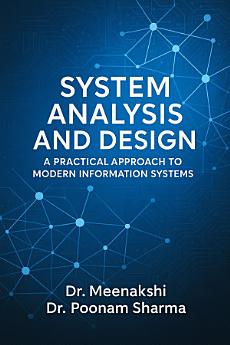System analysis and design: A practical approach to modern information systems
Dr. Meenakshi · Dr. Poonam Sharma
Jul 2025 · Expert Notes, Publisher
5.0star
4 reviewsreport
Ebook
136
Pages
reportRatings and reviews aren’t verified Learn More
About this ebook
The book titled " SYSTEM ANALYSIS AND DESIGN: A PRACTICAL APPROACH TO MODERN INFORMATION SYSTEMS" offers a comprehensive and structured exploration of the full life cycle of information system development, from initial planning to implementation. It begins with foundational concepts in planning and investigation, such as identifying system needs, assessing current capabilities, setting goals, and conducting feasibility studies. The role of the system analyst is then examined in detail, highlighting the core responsibilities, required skills, tools, and evolving position in modern IT environments. The text proceeds to analyze various system development methodologies—including Waterfall, Agile, and Spiral—along with emerging technological influences such as AI and continuous integration. Subsequent chapters emphasize practical application, including methods for information gathering, stakeholder analysis, and interdepartmental communication. Structured analysis tools like Data Flow Diagrams, decision trees, and dictionaries are discussed in the context of system modelling. A dedicated chapter on cost–benefit analysis explains how to quantify costs and benefits for informed decision-making. System design methodologies, review techniques, and IPO charts are presented alongside input/output and form design principles that consider accessibility, validation, and technological integration. The final chapter addresses system implementation, covering testing strategies, conversion methods, post-implementation reviews, software maintenance, and risk management. Overall, the book serves as a critical academic resource for students and professionals in system development.
Ratings and reviews
5.0
4 reviews
Meenakshi Sharma
- Flag inappropriate
- Show review history
July 16, 2025
"‘System Analysis and Design: A Practical Approach to Modern Information Systems’ reflects years of academic experience and classroom insights. It bridges theory with real-world applications, making complex concepts easy to grasp. This book is crafted to guide students and professionals alike in mastering system analysis and design effectively." All the very best
srishti vijay
- Flag inappropriate
July 15, 2025
As someone researching system development, I found this book incredibly practical and well-structured. It covers everything from planning and stakeholder analysis to modern methodologies like Agile and AI integration. The tools and examples are easy to apply, especially for modelling and cost–benefit analysis. Highly recommended for both students and professionals!
Johardie Usman
- Flag inappropriate
July 15, 2025
nice
About the author
Dr. Meenakshi is assistant professor in M. M. Institute of Computer Technology & Business Management Maharishi Markandeshwar (Deemed to be University), Mullana - 133207 Ambala, Haryana (India)
Dr. Poonam Sharma is assistant professor in M. M. Institute of Computer Technology & Business Management Maharishi Markandeshwar (Deemed to be University), Mullana - 133207 Ambala, Haryana (India)
Rate this ebook
Tell us what you think.
Reading information
Smartphones and tablets
Install the Google Play Books app for Android and iPad/iPhone. It syncs automatically with your account and allows you to read online or offline wherever you are.
Laptops and computers
You can listen to audiobooks purchased on Google Play using your computer's web browser.
eReaders and other devices
To read on e-ink devices like Kobo eReaders, you'll need to download a file and transfer it to your device. Follow the detailed Help Center instructions to transfer the files to supported eReaders.


